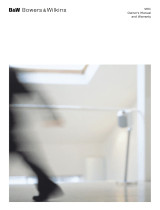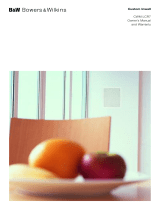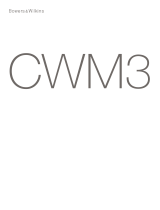
ENGLISH
4 Connecting using the table stand
Remove the rubber mat from the underside of the
base (Figure 15).
Strip back the outer sheath of the cable by 75mm
(3 in) to expose the two inner sheathed wires.
Strip back the positive and negative wires to expose
10mm (3/8 in) of bare wire. If using multi-strand wire,
twist the strands to obtain a neat end.
Feed each wire through the appropriate hole in the
back of the base, observing the polarity coding
as indicated. The wires will follow a channel and
emerge in line with the side holes in the spring
terminals.
Press the ends of the terminals fully and push the
wire into the terminals. Then release the terminal
ends to clamp the wire.
Replace the rubber mat.
5 Fitting and connecting using the
wall bracket
WARNING!
Do not attach the speaker to the ceiling. Decide how
the cable is to be routed to the wall bracket – on the
wall surface (from underneath only), chased into the
plasterwork, or inside hollow (drywall) construction.
If routing the cable inside the wall or in the plaster
layer, install it before xing the wall bracket in place
and leave 50mm (2 in) showing with the outer sheath
stripped back.
Take care to route the cable clear of where the
bracket xing screws will be. For example, if the
cable is chased into the plaster from above, omit the
centre xing screw.
If laying the cable on the wall surface, t the wall
bracket rst. Cable cannot be routed around the
support platform of the bracket when the cover is
in place. There is only one knock-out in the cover
as shown, so the cable must approach from this
direction.
Using a spirit level, offer the wall bracket to the wall
and mark out the xing holes.
Drill and plug the wall as appropriate to the type of
construction (screws and plugs not supplied).
If laying the cable on the wall surface from below,
remove the knock-out at the bottom of the bracket
cover to accommodate the cable.
Strip back the ends of the inner cores of the cable
to expose 10mm (3/8 in) of bare wire and neatly
twist if multi-strand. Connect the wires to the screw
terminals, observing the correct polarity as shown.
Remove the table stand base, following the
instructions in Section 3.1.
Slide the cover up the stem. Make sure the securing
clamp is clear of the stem aperture in the bracket
and push the end of the speaker stem fully into
the aperture. Tighten the two screws through the
securing clamp evenly using the Torx key supplied
until the slack is taken out of the t of the stem.
Check that the tapered ridge of the clamp engages
the groove in the stem. Do not over-tighten.
Slide the cover back down the stem and click into
place on the wall bracket.
5
Figure 15
Figure 16
+
+
+















